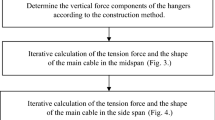Abstract
A systematic and generic procedure for the determination of the reasonable finished state of self-anchored suspension bridges is proposed, the realization of which is mainly through adjustment of the hanger tensions. The initial hanger tensions are first obtained through an iterative analysis by combining the girder-tower-only finite element (FE) model with the analytical program for shape finding of the spatial cable system. These initial hanger tensions, together with the corresponding cable coordinates and internal forces, are then included into the FE model of the total bridge system, the nonlinear analysis of which involves the optimization technique. Calculations are repeated until the optimization algorithm converges to the most optimal hanger tensions (i.e. the desired reasonable finished bridge state). The “temperature rigid arm” is introduced to offset the unavoidable initial deformations of the girder and tower, which are due to the huge axial forces originated from the main cable. Moreover, by changing the stiffness coefficient K in the girder-tower-only FE model, the stiffness proportion of the main girder, the tower or the cable subsystem in the whole structural system could be adjusted according to the design intentions. The effectiveness of the proposed method is examined and demonstrated by one simple tutorial example and one self-anchored suspension bridge.
Similar content being viewed by others
References
GIL H, CHO C. Yong Jong grand suspension bridge, Korea [J]. Structural Engineering International, IABSE, 1998, 8(2): 97–98.
KIM H K, LEE M J, CHANG S P. Non-linear shape-finding analysis of a self-anchored suspension bridge[J]. Engineering Structures, 2002, 24: 1547–1559.
SUN J, MANZANAREZ R, NADER M. Design of looping cable anchorage system for new San Francisco-Oakland Bay bridge main suspension span [J]. J Bridge Eng, 2002, 7(6): 315–324.
LI Chuan-xi, KE Hong-jun, LIU Hai-bo, XIA Gui-yun. Determination of finished bridge state of self-anchored suspension bridge with spatial cables [J]. Engineering Mechanics, 2010, 27(5): 137–146. (in Chinese)
ZHANG J, LIU A, MA Z, HUANG H, MEI L, LI Y. Behavior of self-anchored suspension bridges in the structural system transformation [J]. J Bridge Eng, 2013, 18(8): 712–721.
LI J H, LI A Q, FENG M Q. Sensitivity and reliability analysis of a self-anchored suspension bridge [J]. J Bridge Eng, 2013, 18(8): 703–711.
CHEN D W, AU F T K, THAM L G, LEE P K K. Determination of initial cable forces in prestressed concrete cable-stayed bridges for given design deck profiles using the force equilibrium method [J]. Computers & Structures, 2000, 74: 1–9.
WANG P H, TSENGT C, YANG C G. Initial shape of cable-stayed bridges [J]. Computers & Structures, 1993, 47: 111–123,.
KIM K S, LEE H S. Analysis of target configurations under dead loads for cable-supported bridges [J]. Computers & Structures, 2001, 79: 2681–2692.
LI J H, LI A Q, YUAN H H. Calculation method of spatial cable curve for single-pylon self-anchored suspension bridge [J]. Journal of Highway and Transportation Research and Development, 2009, 26(10): 66–70. (in Chinese)
HAN Y, CHE Z Q, LUO S D, YANG S K. Calculation method on shape finding of self-anchored suspension bridge with spatial cables [J]. Front Archit Civ Eng China, 2009, 3(2): 165–172.
IMO I I, LEECH D J. Discontinuous optimization in batch production using SUMT [J]. Int J Prod Res, 1984, 22(2): 313–321.
DAI Y H. Convergence properties of the BFGS algorithm [J]. Siam J Optim, 2002, 13(3): 693–701.
Author information
Authors and Affiliations
Corresponding author
Additional information
Foundation item: Project(20133204120015) supported by Specialized Research Fund for the Doctoral Program of Higher Education of China; Project(12KJB560003) supported by the Natural Science Foundation of the Higher Education Institution of Jiangsu Province, China
Rights and permissions
About this article
Cite this article
Li, Jh., Feng, Dm., Li, Aq. et al. Determination of reasonable finished state of self-anchored suspension bridges. J. Cent. South Univ. 23, 209–219 (2016). https://doi.org/10.1007/s11771-016-3064-6
Received:
Accepted:
Published:
Issue Date:
DOI: https://doi.org/10.1007/s11771-016-3064-6




